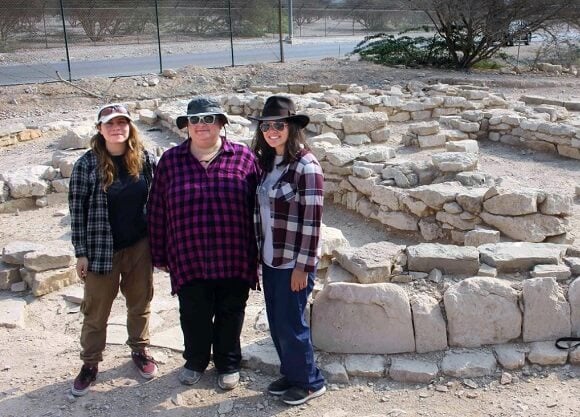
Students embark on adventure in United Arab Emirates
February 01, 2017

February 01, 2017

While it sounds like the next movie in the Indiana Jones franchise, the excursion to the United Arab Emirates was just as exciting for students Erika Danella '19 and Whitney Wachtarz '18, and Jaime Ullinger, assistant professor of anthropology. The trio spent three weeks sorting and evaluating bones from the tombs of Umm an-Nar, a Bronze Age culture and time period—also known as the “mother of fire”—that existed from 2600-2000 BC in modern-day UAE.
Erika Danella '19, Whitney Wachtarz '18 and Professor Jaime Ullinger is Quinnipiac’s first research group to travel to the United Arab Emirates.
Their team also included Professor Lesley Gregoricka of the University of South Alabama and two of her students and was the first all-female group to conduct research at the site. That fact made local leaders take notice and prompted an invitation to meet with His Highness Sheikh Saud bin Saqr al-Qasimi, Ruler of the Emirate of Ras al-Khaimah and a member of the Federal Supreme Council of the United Arab Emirates.
“He was incredibly welcoming and incredibly supportive of our project,” said Ullinger, who said both the Sheikh and the community are interested in learning more about this time period in their history.
“Drinking coffee with him and eating fresh dates from his royal orchards was a pretty phenomenal experience,” Ullinger said.
The students were impressed by the beautiful palace. Danella, a biology major and anthropology minor, said, “It was cool to talk to him about the work we were doing, and he was really interested.”
Ullinger received Quinnipiac’s Galpin International Exchange Faculty Fellows grant, which helped fund the trip. The students took an independent research class with Ullinger in the fall to prepare.
Using a variety of bioarchaeological techniques, the team endeavored to learn more about the diet, health and behavior of the Umm an-Nar people and their mortuary practices, which included burying large numbers of people in communal tombs.
The team sorted and began to identify a collection of bones that had been excavated in the late 1990s. Most of the bones exist in fragments, Ullinger said, noting that it is possible to identify the age and gender of the person they belonged to.
“The bones can tell us what people were eating, how the environment affected their health, and how they interacted with their environment over time. We also can compare the health of people who had access to water year-round to the bones of people living in other areas who did not,” Ullinger said.
She pointed out that chemical analysis of teeth also can provide clues––from cavities, dental abscesses and absence of teeth lost before death.
Ullinger said the students applied knowledge gleaned in an anatomy class to a real-life situation. “We got through both bone collections, and we accomplished what we needed to. The students worked hard and did a great job.”
Wachtarz, a criminal justice major and anthropology minor, said working onsite was more difficult than she anticipated. “When you are dealing with bones that have been burned, they are warped, and some cannot be identified,” she noted. Sometimes, the students would sort bones into a less relevant pile only to find out later that those bones held important information.
This trip laid the foundation for a long-term collaborative project with researchers in the United Arab Emirates. In addition to new research skills, the students gained a better understanding of the region and its culture by visiting museums and touring other archaeological sites.
“Simply interacting with other people and understanding our commonalities beyond our differences was pretty important,” Ullinger said.
Both professors are collaborating on a National Science Foundation grant that would fund further research opportunities for undergraduate students at the UAE site. Some of those bones will be traveling to Quinnipiac, where the group will work with the university’s Bioanthropology Research Institute, known for providing non-destructive digital imaging to anthropological samples.
“We hope to use X-ray, CT and Micro-CT to understand more about internal structures in bone without having to damage the bone. We can see things like healed fractures and disease processes that would not otherwise be visible,” Ullinger said.
Quinnipiac Today is your source for what's happening throughout #BobcatNation. Sign up for our weekly email newsletter to be among the first to know about news, events and members of our Bobcat family who are making a positive difference in our world.
Sign Up Now